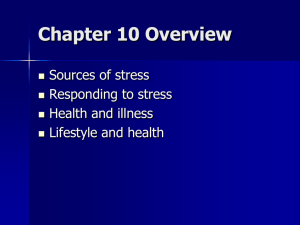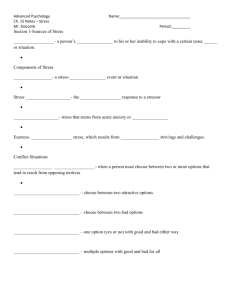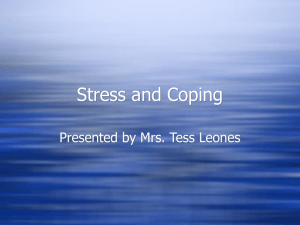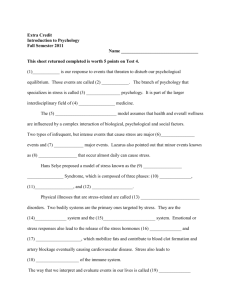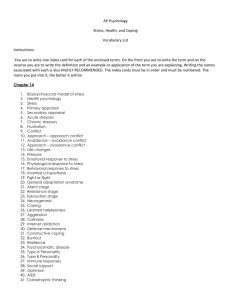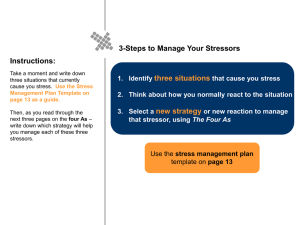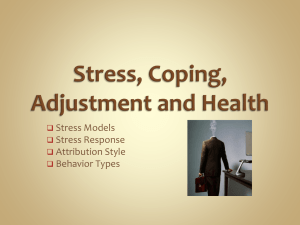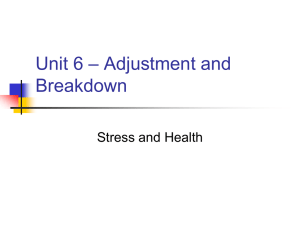Psych 2 - Huber Heights City Schools
advertisement
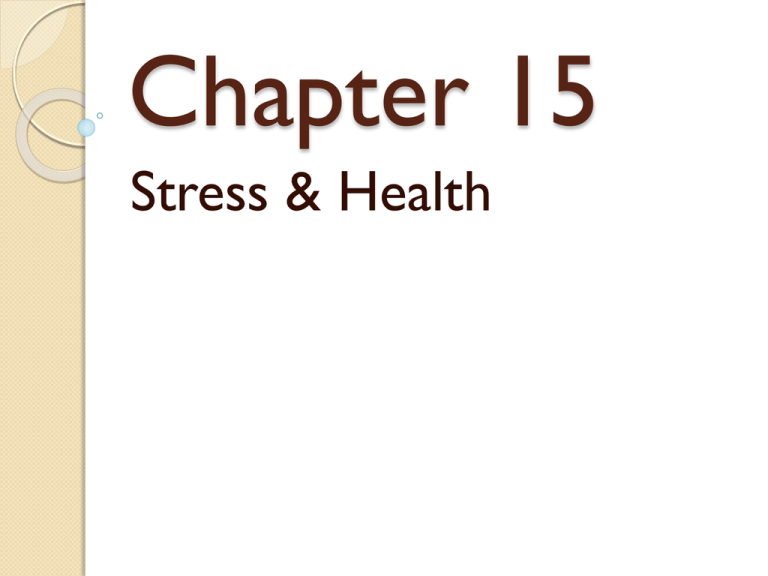
Chapter 15 Stress & Health Types of Stressors A. Psychological Conflict 1. Approach-approach – choosing between one of two attractive goals. 2. Avoidance-avoidance – choosing between two unattractive options. 3. Approach-avoidance – choosing a goal that has both attractive and unattractive features. 4. Double approach-avoidance – choosing between two alternatives that have both positive and negative features. B. Everyday hassles – minor everyday occurrences that can be distressing, frustrating and irritating. C. Life changes – personal changes in a person’s life that require adaptation/adjustment D. Catastrophes – unpredictable, large-scale events, such as natural disasters or devastations E. Poverty and inequality – low economic status F. Discrimination – prejudice and perceived unfairness G. Adjustment to a new culture – when immigrants are adjusting to life in a new culture The Game of Life Select a given number of items from the following lists of stressors, with the intention of maximizing your health and resiliency. Once you have made your selections, explain why you chose the items you did and what impact you would expect them to have on your health and happiness. Compare your answers with those of your classmates and discuss the differences in personality, event appraisal, and personal habits that led to your decisions. Category I (Choose 1) • Living in a country experiencing war • Living through a major earthquake • Losing your home and possessions because of a fire • Living near a nuclear disaster site • Having a close relative die in an accident Category II (Choose 3) • Death of a close relative • Getting married • Losing a job • Having triplets • Living 2,000 miles from family • Moving to a new city • Developing a serious illness • Buying an expensive house • Getting a promotion at work • Having a 2-hour heavy-traffic commute every day • Getting divorced Category III (Choose 5) • Getting stuck in construction traffic & being 3 hours late getting home • Waiting in line at the post office for 1 hour to mail your taxes • Having two exams the day before your sister’s wedding • Locking your keys in the car • Forgetting your notes for a presentation • Getting a speeding ticket • Losing your keys on the morning of a big job interview • Having a fight with your roommate • Bouncing a check • Having to find a new apartment CHAPTER 15 SECTION 1 Sources of Stress Stress – an anxious or threatening feeling resulting from our appraisal of a situation & our reaction to demands placed upon us. Components of Stress I. Stressor – a stress-producing event or situation. A. what is a stressor for one person may not be for another. II. Stress reaction – the body’s observable response to a stressor whether perceptual, cognitive, physical or emotional III. There are different types of stress A. Distress – negative stress that stems from acute anxiety or pressure & can take a harsh toll on the mind and body. B. Eustress – positive stress which results from the strivings and challenges that are the spice of life. IV. Stress is a normal, even essential, part of life that goes hand in hand with working toward any goal or facing any challenge. It can spur us on to greater effectiveness & achievement in some situations. We cannot escape stress, however, we can learn to cope with stress so that it makes our lives interesting without overwhelming us. Conflict Situations We often have to evaluate situations & then make difficult decisions between two or more options which fall into four broad categories 1. Approach – Approach – choosing between two attractive options. A. High school senior having to decide between two colleges. B. Does not produce a great deal of stress because both choices are satisfying. 2. Avoidance – Avoidance – choosing between two disagreeable options A. College graduate unable to find a job but is offered a job with no future & low pay. Do they accept it or continue looking for something better? B. Either will be frustrating & there is usually a high level of indecision and stress. 3. Approach – Avoidance – choosing to do something that has both enjoyable and disagreeable consequences. A. Wanting to ask for a raise but being afraid to be fired. B. The degree of stress depends on the intensity of the desire or of the perceived threat. 4. Double Approach – Avoidance – choosing between two or more alternatives, each with attractive & unattractive aspects. A. Taking vacation in Paris which would be expensive or Florida which would be cheaper but less exciting. B. The degree of stress generated depends on the intensity of the attractions & repulsions. Appraising a Situation The level of stress you feel depends on how you appraise the situation. 1. Primary appraisal – our immediate evaluation of a situation. A. Three ways you can appraise a situation – irrelevant, positive & negative 2. Secondary appraisal – involves how to deal with a potentially stressful situation, deciding on a coping strategy. Environmental Stressors Environmental conditions such as noise may cause stress on the job & these factors can have similar effects on the public at large. People exposed to excessive noise at work have reported more headaches, nausea & moodiness than others. Crowding is an environmental stressor as well. Studies have shown a relationship between high-rise apartments with many people & aggression. Life Changes & Stress Major life changes are important sources of stress. Common to these events is the separation of an individual from familiar friends, relatives or colleagues. A scale was developed to measure the effects of 43 common events. Each event was rated on a scale of 1 to 100 on how much adjustment the event required. Cons: Scale was created in 1967 & was based on the stress in men’s lives and fails to measure stress caused by ongoing situations such as racism and poverty. Life event Life change units Death of a spouse 100 Divorce 73 Marital separation 65 Imprisonment 63 Outstanding personal achievement 28 Spouse starts or stops work 26 Begin or end school 26 Change in living conditions 25 Revision of personal habits 24 Trouble with boss 23 Change in working hours or conditions 20 Change in residence 20 Change in schools 20 Change in recreation 19 Change in church activities 19 Change in social activities 18 Minor mortgage or loan 17 Change in sleeping habits 16 Change in number of family reunions 15 Social Readjustment Rating Scale Death of a close family member 63 Personal injury or illness 53 Marriage 50 Dismissal from work 47 Marital reconciliation 45 Retirement 45 Change in health of family member 44 Pregnancy 40 Sexual difficulties 39 Gain a new family member 39 Business readjustment 39 Change in financial state 38 Death of a close friend 37 Change to different line of work 36 Change in frequency of Change in eating habits Arguments 35 Major mortgage 32 Foreclosure of mortgage or Loan 30 15 Vacation 13 Christmas 12 Minor violation of law 11 Change in responsibilities at Work 29 Child leaving home 29 Trouble with in-laws 29 Score of 300+: At risk of illness. Score of 150-299+: Risk of illness is moderate (reduced by 30% from the above risk). Score 150-: Only have a slight risk of illness. Life Event Life Change Units Getting married 95 Unwed pregnancy 100 Death of parent 100 Acquiring a visible deformity 80 Divorce of parents 90 Fathering an unwed pregnancy 70 Jail sentence of parent for over one year 69 Death of a brother or sister 68 Change in acceptance by Pregnancy of unwed sister Beginning to date 51 Suspension from school 50 Becoming involved with drugs or alcohol 50 Birth of a brother or sister 50 Increase in arguments between parents 47 Loss of job by parent 46 Outstanding personal achievement 46 Change in parent's financial status 45 Accepted at college of choice 43 Being a senior in high school 42 Hospitalization of a sibling 41 Increased absence of parent from home 38 Brother or sister leaving home 37 Addition of third adult to family 34 Becoming a full fledged member of a church 31 Decrease in arguments between parents 27 Decrease in arguments with parents 26 Mother or father beginning work 26 67 64 Discovery of being an adopted child 53 70 Marital separation of parents peers Breaking up with boyfriend or girlfriend 63 Marriage of parent to stepparent Death of a close friend 63 63 Having a visible congenital deformity 62 Serious illness requiring hospitalization Failure of a grade in school 58 56 Not making an extracurricular activity Hospitalization of a parent 55 55 Jail sentence of parent for over 30 days 53 Score of 300+: At risk of illness. Score of 150-299+: Risk of illness is moderate. (reduced by || 30% from the above risk) Score 150-: Slight risk of illness. Hassles In addition to major stressful events, psychologists have also studied the effects that relatively minor, day-to-day stressors have on heath. • household duties • concerns about health • time pressures • environmental hassles • financial hassles • worries about your job • concerns about your future • inner hassles (low self-esteem or loneliness) Research has found a connection between hassles & health problems. Hassles can weaken the body’s defense system, making it harder to fight off potential health problems. It has also been suggested that small, positive events called uplifts can reduce stress & protect a person’s health. CHAPTER 15 SECTION 2 Reactions to Stress There are a wide variety of stress reactions and their effects range from beneficial to harmful. Fight-or-Flight Response Regardless of the stressor, the body reacts with immediate arousal. The adrenal glands are stimulated to produce: 1. Hormones that increase the amount of blood sugar for extra energy. 2. Adrenaline, which causes rapid heartbeat and breathing and enables the body to use energy more quickly This response is needed for survival. It prepares you to face potentially dangerous situations. General Adaptation Syndrome Hans Selye identified three stages in the body’s stress reaction 1. Alarm – the mobilizes its fight-or-flight defenses; heartbeat & breathing quicken, muscles tense, the pupils dilate & hormones that sustain these reactions are secreted. The person becomes exceptionally alert & sensitive to stimuli in the environment & tries to keep a firm grip on their emotions. 2. Resistance – the person often finds a means to cope with the stressor & to ward off, superficially at least, adverse reactions. Person may suffer psychosomatic symptoms which result from the stress. 3. Exhaustion – adrenal & other glands are at their limit, unable to secrete hormones & the person becomes exhausted, disoriented & may delusions in an effort to retain some type of coping strategy. Emotional & Cognitive Responses Short-Term psychological stress reactions may be either emotional or cognitive 1. Emotional a. Anxiety – a feeling of an imminent but unclear threat. The most common response. b. Anger – most likely to result from a frustration. c. Fear – usually the reaction when a stressor involved real danger. Fear directs people to withdraw or flee but in severe cases they may panic and be unable to act. 2. Cognitive a. Difficulty in concentrating or thinking clearly b. Recurring thoughts c. Poor decision making d. Unjustified suspicion or distrust of others Behavioral Responses There are many short-term behavioral changes that result from stress. 1. Person may develop nervous habits, gulp meals, smoke or drink more, take drugs or feel tired for no reason, temporarily lost interest in eating, grooming, bathing, etc and become more aggressive 2. Escape is another behavioral stress reaction & it is often the best way to deal with frustration. 3. Some behavioral reactions are positive because some people will risk their lives to save or help others in crisis situations. Physical Responses Our thoughts & emotions can produce physiological changes in our bodies 1. Some people develop psychosomatic symptoms as a result of stress such as headaches, stomachaches & muscle pains. 2. Prolonged physical arousal can cause health problems, including difficulty in breathing, insomnia, migraine headaches, urinary & bowel irregularities, muscle aches, sweating & dryness of mouth 3. Stress is clearly related to illnesses and can be either the direct cause of illness, such as a migraine or indirectly by suppressing our immune system & making us more vulnerable to diseases & infections. Factors Influencing Reactions to Stress People’s reactions to stress vary considerably based on: 1. Personality Differences a. Type A verses Type B b. Emotional expressiveness i. 2. People who neither express nor admit to strong feelings of despair, depression and anger are more likely to develop cancer than those who can give vent to their emotions. Perceived Control Over Stressors a. People prefer to have predictable stress over unpredictable stress in which they have no control over. Our physical & psychological wellbeing is profoundly influenced by the degree to which we feel a sense of control over our lives. 3. Social Support a. Social support can help people decrease the effects of stressful situations by providing a buffer from the effects of stress. b. Social groups offer at least four kinds of support. i. Emotional support involves concerned listening, which forms a basis for offering affection & concern & bolstering the stressed person’s self-confidence. ii. Appraisal support allows the stressed person to get feedback about the stress & help in sorting out, understanding & dealing with the situation at hand. iii. Informational support emerges from appraisal support where the stressed person responds to what they have learned & evaluates the manner in which they are dealing with stressors. iv. Instrumental support represents active, positive support in the form of direct help such as money or a place to live CHAPTER 15 SECTION 3 Coping with Stress Coping with stress is an attempt to gain control over a part of one’s life. There is not just one way that is best for all people in all situations. Coping strategies may not always be healthy ways to adapt. These are known as maladaptive ways of coping. Psychological Coping Strategies 1. Defensive Coping Strategies a. We try to influence our cognitive appraisals by means of defensive coping strategies and stress reactions are more likely to occur when these strategies fail. i. Denial – person decides that the event is not really a stressor ii. Intellectualization – person watches & analyzes the situation from an emotionally detached standpoint. Active Coping Strategies 1. Hardiness – refers to the personality traits of control, commitment & challenge that help us reduce the stress we feel. a. Control – feeling that we have the ability to affect the outcome of the situation. b. Commitment – establishing & pursuing our goals c. Challenge – actively confronting & solving problems instead of feeling threatened & powerless because of them. 2. Controlling stressful situations – controlling our exposure to stressful events & thereby reducing levels of stress. 3. Problem solving – regarding frustrations or conflicts as problems to be solved means the situation becomes a positive challenge rather than a negative setback. 4. Explanatory style – two very different styles of thinking. a. Optimist typically puts the best face on any set of events. b. Pessimist always sees the dark side. 5. Relaxation – techniques of relaxation have been developed especially to cope with stress. a. Progressive relaxation involves lying down comfortably & tensing and releasing the tension in each major muscle group in turn. b. Meditation involves focusing of attention with the goal of clearing one’s mind and producing an “inner peace” 6. Humor – Laughing actually releases the tension of pent-up feelings and can help you keep a proper perspective of the situation. 7. Exercise – Physical exercise is another constructive way to reduce stress and helps to burn off stress hormones. 8. Support groups & professional help – help people with specific stress-related problems. 9. Training – new, unfamiliar or dangerous situations can be stressful because we are unsure we can deal with it. Training to prepare for such a situation can ease the stress. 10. Improving interpersonal skills – developing skills in dealing with other such as family, friends and coworkers is one of the best ways to manage stress. Being able to interact well with others increases your self-confidence and self-esteem. CHAPTER 15 SECTION 4 Stress in Your Life Growing up involves gaining a sense of autonomy and independence. Each person learns to make decisions, develop a value system, be responsible and to care for themselves and means separating from the family, both physically & emotionally Choosing College College is one of the first big steps toward separation. As college students, individuals are freer than they ever have been or may eve be again. This can be exciting but will also acquire adjustment. 1. Many students approach college with high & often unrealistic aspirations and many will use their experiences in the first semesters of college to change their minds & images of themselves. 2. College also challenges the identity a student has established in high school a. Ex. Star pupil in high school at a competitive college struggles to get average grades where every student is bright & competitive. 3. Individuals are likely to encounter greater diversity in college than they ever have before and may have to reexamine their basic assumptions & perhaps adopt new ideas & beliefs (developmental friendships) Coping with Change 1. Some focus their efforts to succeed in the field they have chosen even though they may have doubts which can lead them leaving college with a degree they don’t want. 2. Others avoid confronting doubt by frittering away their time, going through the motions of attending college but detaching themselves emotionally. 3. Some manage to keep their options open until they have enough information & experience to make a choice – resynthesis – combining old ideas with new ones & reorganizing feelings in order to renew one’s identity. Working Graduating from college or high school involves thinking about & finding your first job & your career. What a person sees at work can differ but whatever is chosen can bring satisfaction and/or dissatisfaction. Research has identified five major sources of work satisfaction. 1. Resources – Does the worker have what they need to get the job done? 2. Financial Reward – Pays well, good benefits & is secure. 3. Challenge – Job is interesting & allows the worker to use their talents. 4. Relations with coworkers – Worker is on good terms with colleagues 5. Comfort – working conditions & related factors are attractive.
